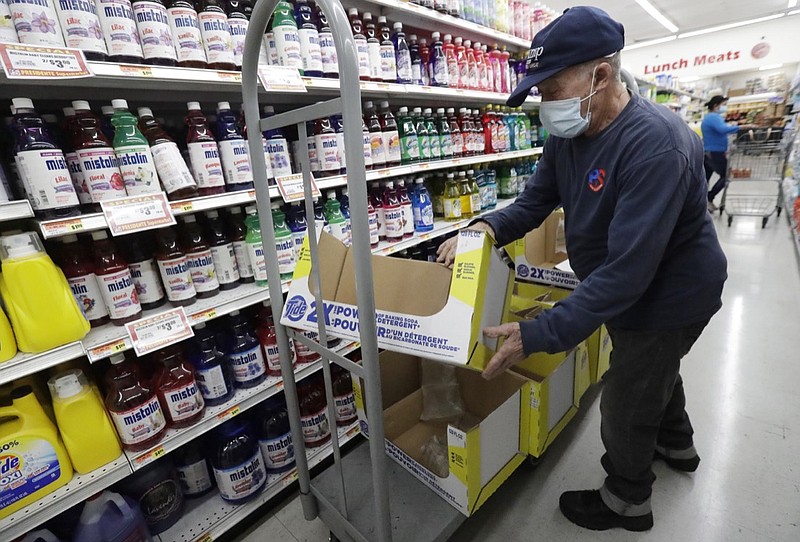Nearly 1.9 million people applied for U.S. unemployment benefits last week, the ninth straight decline since applications spiked in mid-March, a sign that the gradual reopening of businesses has slowed the loss of jobs.
The diminishing pace suggests that the job market meltdown that was triggered by the coronavirus may have bottomed out as more companies call at least some of their former employees back to work.
In Tennessee, the number of initial claims for jobless benefits last week totaled 22,784 - the lowest weekly total in 10 weeks. Those first-time filings for unemployment aid included 1,798 in the 10-county Southeast Tennessee district around Chattanooga, which also was the lowest since early March.
Since mid March, a total of 581,405 workers in Tennessee have filed for jobless benefits. That's equal to nearly 18% of the jobs in the state in early March before the coronavirus pandemic shut down hit the economy, suggesting that Tennessee's record high 14.7% jobless rate in April is likely to be even higher when the May results are announced later this month.
Nationwide, the total number of people who are now receiving jobless aid rose only slightly to 21.5 million as the economy has begun to reopen and rehiring is offsetting some of the ongoing layoffs.
In Chattanooga, Nneka Ijeoma lost her job as a bartender at a whiskey bar when it closed in March. Though the bar has reopened, it has rehired only two of its 17 employees. In the meantime, Ijeoma is receiving $275 in state unemployment benefits each week, plus $600 a week in federal benefits
"We were honestly so blessed by that," she said of the federal aid, which will expire at the end of July. "I wouldn't have been able to get by on $275."
Last week, the Tennessee Department of Labor and Workforce Development said it paid out $285.7 million in jobless benefits to 314,135 unemployed Tennesseans, or an average of $909.52. Some of those payments reflect the state catching up for previous weeks of unpaid claims as officials continue to work through a backlog of cases stemming from the record number of filings.
Although the jobless benefits are helping pay her bills, Ijeom said she is eager to return to work and to go back to school in the fall to finish her college degree. Yet she always regarded bartending as a long-term opportunity.
"I always thought I could work in hospitality forever," she said. "I thought it was recession-proof."
Although restaurants began opening for indoor seating last month in Tennessee, their capacity is still limited and many consumers remain wary about eating out or going to places where they might be exposed to the virus from other people.
Though applications for jobless benefits are slowing, the latest weekly number is still more than double the record high that prevailed before the viral outbreak. It shows that there are limits to how much a partial reopening of the economy can restore a depressed job market mired in a recession.
In addition to the laid-off employees who applied for benefits last week, 623,000 others sought jobless aid under a new program for self-employed and gig workers, who now qualify for unemployment benefits for the first time. These figures aren't adjusted for seasonal variations, so the government doesn't include them in the overall data.
The figures come one day before the government's jobs report for May is expected to show that employers slashed 8 million jobs last month and that the unemployment rate jumped from 14.7% to 19.8%. If those forecasts prove accurate, it would mean that nearly 30 million people have lost jobs since the viral outbreak intensified in March and that joblessness has reached its highest point since the Great Depression.
Since mid-March, 42.7 million people have applied for unemployment benefits. Not all of them are still unemployed, though. Some have since been rehired. And some laid-off people, it turns out, filed duplicate applications for benefits as they struggled with unresponsive state unemployment systems.
Thursday's report wasn't affected by the protests over the killing of George Floyd, which in recent days forced some major retailers and small businesses to close, because it covers claims filed only through May 30. But some economists warn that applications for unemployment aid could rise in next week's report, reflecting business closures amid the protests and scattered vandalism.
"That's going to kick up the claims again," said Jane Oates, a former Labor Department official.
The depth of the job cuts since the virus forced the widespread shutdown of businesses reflects an economy gripped by the worst downturn since the Great Depression. The economy is thought to be shrinking in the April-June quarter at an annual rate approaching 40%. That would be, by far, the worst quarterly contraction on record.
Still, real-time private data on consumer behavior is showing signs that the economy is gradually reviving. Credit and debit card spending tracked by Chase Bank shows that consumer spending, though roughly flat last week, rebounded from its low point in mid-April, when it was 40% below year-ago levels. Now, it is down 20% from a year ago.
Economists caution that most Americans will need to feel more confident about returning to their former habits of shopping, traveling and eating out before the economy can sustain any meaningful recovery. That will likely require the availability of a vaccine or a significant increase in testing.
"What's really going to move the needle economically is when consumers and businesses feel comfortable re-engaging with the economy the way they did before COVID-19," said Adam Kamins, a senior regional economist at Moody's Analytics.
